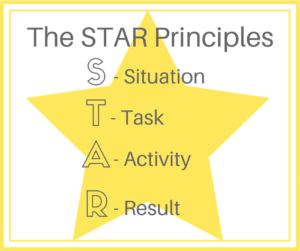When preparing for interviews, you may well have come across something called the STAR Principles, or the STAR Method.
Most commonly used in competency interviews, this method allows you to structure your response to questions that will often begin with ‘Tell me about a time when…’.
So what are the STAR Principles? And how do you use them in interviews?
In this article, we are going to take a look at what the STAR Principles are and how to apply them when answering interview questions.
What are the STAR Principles?
The STAR Principles are very simple;
S – Situation
T – Task
A – Activity
R – Result
Do you see what they’ve done there?
If you are asked a competency question, using the STAR method will help you answer in a clear and concise manner. Now let’s put it into practice;
How to use the STAR method in an interview
Let’s take the question ‘Tell me about a time you had to work to a tight deadline’. As an accountant, you should be able to work well under pressure and there are times when you will have to be working to a strict deadline. Your interviewer will want to see that you are up to task and the best way to prove this is using the STAR principles.
So, how would you go about answering this question using the principles above?
S- Situation
Think of a situation similar to what the interview is asking about that had a successful outcome. It doesn’t have to be in the workplace, as a graduate you may not have had much office experience and therefore you may want to use a different example. That said, if you do have an example from a previous internships or work experience, then it’s always a good idea to use it.
Briefly describe the situation, remember to include who, what, where, when and how. Do try to keep it brief though, your interviewer doesn’t need to know what the weather was like that day (unless relevant to the story, of course).
For example: During my accountancy placement, we were tasked with individual projects that we would present at the end of our placement. These would relate to real ongoing projects the rest of the company was undertaking. However, one of the interns was taken ill and signed off for the last leg of the placement, leaving their presentation unfinished.
Here, you have described where you were and when (your placement year), what (an individual project), who was involved (yourself and other interns) and how this situation came about (an intern was taken ill, leaving their project unfinished).
T – Task
Here, you will describe what task you were given and how it relates to the example you are giving. So in this instance, you will reference the tight deadline.
For example: My supervisor instructed me to finish the project and present it. We could not extend the deadline as it was nearing the end of the placement. I had just a week to finish a project another accountancy student had been working on for seven weeks while also finishing my own presentation.
You have then described the task at hand and how long you were given to do it.
A – Action
What did you do to solve the problem?
Go into more detail here, and explain what you did to achieve the goal you had been set. Interviewers want to see that you are pro-active and ready to take on challenges, but they also want to see that you can manage projects and work efficiently. Explain how you prioritised the projects and whether you asked for help and allocated work to different team members. Asking for help is not a bad thing, especially when assigning work to others shows initiative and leadership.
For example: As I knew that this would take time and was an absolute priority, I asked my supervisor if some of the students were happy to take on some other tasks that I was assigned to do. I helped allocate these tasks to the others, who were happy to help, so that I could get on with the task at hand.
This shows that you know how to prioritise your workload and show leadership skills when it came to delegating other tasks.
R – Result
And finally, you will tell the interviewer about the end result. Explain how your actions meant that you could complete the task at hand within the required timeframe and to a high standard. If you were praised for your work, tell the interviewer this. You can also use this opportunity to describe the skills you learnt or developed while carrying out the task and how this will make you suited to the job you are applying for.
For example: After allocating some of my other tasks to the other students, I was able to focus on both of the projects. I completed them in the required timeframe and was able to present them to the senior members of the company with ease. I was praised by my supervisor for my efficiency and my positive attitude and received a notable mention at the end of my placement because of this.
The final part of your answer should show how successfully you completed the task and the outcome of this success.
How to get the most out of the STAR Method
Here are some top tips for using the STAR Principles in interviews;
- Be prepared
- Have a few examples ready before you go into the interview. They don’t all have to be work-related, but you should be prepared to bring the story back to how it has helped you in the workplace.
- Be specific
- Be quantitative
- Back up your successes with facts and figures
- Be concise
- Be honest
- If you cannot for the life of you think of an example of when you had to work with a particularly difficult client, tell the interviewer. Don’t make up a story, when they begin to ask questions it will quickly unravel. Instead, flip it back to you and say something such as ‘but if I was in that situation, I would…’
And that’s how you answer a question using the STAR Principles. It might seem long, but following this method will give you the type of detailed response the interviewer is looking for when they asked this question. You should practice this as much as possible, as a good STAR answer should not sound like you are following the method when you put it together. Instead it should simply sound like a well-structured answer. Good luck!





